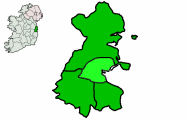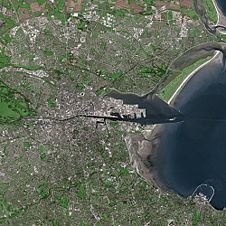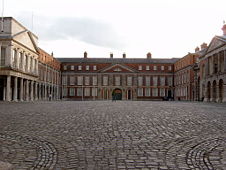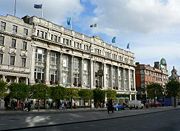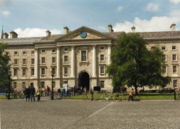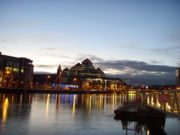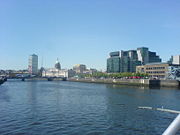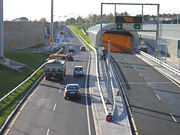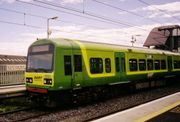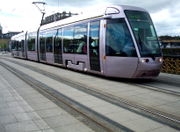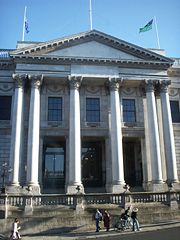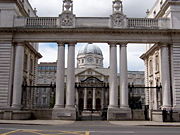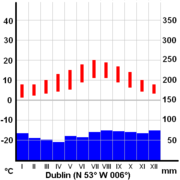Dublin
2008/9 Schools Wikipedia Selection. Related subjects: Europe; European Cities
| Dublin Baile Átha Cliath |
||
 |
||
|---|---|---|
| Obedientia Civium Urbis Felicitas Latin: literally, "The citizens' obedience is the city's happiness" (rendered more loosely as "Happy the city where citizens obey" by the council itself) |
||
| Location | ||
|
|
||
|
WGS-84 ( GPS) Coordinates:
|
||
| Statistics | ||
| Province: | Leinster | |
| County: | County Dublin | |
| Dáil Éireann: | Dublin Central, Dublin North Central, Dublin North East, Dublin North West, Dublin South Central, Dublin South East, Dún Laoghaire and Rathdown | |
| European Parliament: | Dublin | |
| Dialling code: | +353 1 | |
| Postal district(s): | D1-24, D6W | |
| Area: | 114.99 km² (44 sq mi) | |
| Population (2006) | Dublin City: 505,739 Dublin Urban Area: 1,045,769 Dublin Region: 1,186,821 Greater Dublin Area: 1,661,185 |
|
| Website: www.dublincity.ie | ||
Dublin (pronounced /ˈdʌblɨn/, /ˈdʊblɨn/, or /ˈdʊbəlɪn/, Irish: Baile Átha Cliath, meaning Town of the Hurdled Ford, pronounced [bˠalʲə aːha klʲiəh] or [bˠɫaː cliə(ɸ)]) is both the largest city and the capital of Ireland. It is located near the midpoint of Ireland's east coast, at the mouth of the River Liffey and at the centre of the Dublin Region. Founded as a Viking settlement, the city has been Ireland's primary city for most of the island's history since medieval times. Today, it is an economic, administrative and cultural centre for the island of Ireland and has one of the fastest growing populations of any European capital city.
Dublin is one of the constituent cities in the Dublin-Belfast corridor region which has a population of just under 3 million.
The name Dublin is a Hiberno-English derivative of 'Dubh Linn' (Irish, dubh -> black, and linn -> pool). Historically, in the traditional Gaelic script used for the Irish language, 'bh' was written with a dot over the 'b', viz 'Duḃ Linn' or 'Duḃlinn'. The French-speaking Normans omitted the dot and spelled the name variously as 'Develyn' or 'Dublin'.
The common name for the city in Modern Irish is 'Baile Átha Cliath' ('The Settlement of the Ford of the Reed Hurdles'). 'Áth Cliath' is a place-name referring to a fording point of the Liffey in the vicinity of Heuston Station. 'Baile Átha Cliath' was later applied to an early Christian monastery which is believed to have been situated in the area of Aungier Street currently occupied by St Valentine's (Roman Catholic) church. Due to its length, it is sometimes abbreviated as BÁC.
The subsequent Scandinavian settlement was on the River Poddle, a tributary of the Liffey, to the East of Christchurch, in the area known as Wood Quay. The Dubh Linn was a lake used by the Scandinavians to moor their ships and was connected to the Liffey by the Poddle. The Dubh Linn and Poddle were covered during the early 1800s, and as the city expanded they were largely forgotten about. The Dubh Linn was situated in the area of the park of the Chester Beatty Library in Dublin Castle.
History
The writings of the Greek astronomer and cartographer Ptolemy provide perhaps the earliest reference to human habitat in the area now known as Dublin. In around A.D. 140 he referred to a settlement he called Eblana Civitas. The settlement 'Dubh Linn' dates perhaps as far back as the first century BC and later a monastery was built there, though the town was established in about 841 by the Norse. The modern city retains the Anglicised Irish name of the former and the original Irish name of the latter. After the Norman invasion of Ireland, Dublin became the key centre of military and judicial power, with much of the power centering on Dublin Castle until independence. From the 14th to late 16th centuries Dublin and the surrounding area, known as the Pale, formed the largest area of Ireland under government control. The Parliament was located in Drogheda for several centuries, but was switched permanently to Dublin after Henry VII conquered the County Kildare in 1504.
Dublin also had local city administration via its Corporation from the Middle Ages. This represented the city's guild-based oligarchy until it was reformed in the 1840s on increasingly democratic lines.
From the 17th century the city expanded rapidly, helped by the Wide Streets Commission. Georgian Dublin was, for a short time, the second city of the British Empire after London and the fifth largest European city. Much of Dublin's most notable architecture dates from this time and is considered a golden era for the city. The famous Guinness brewery was also established at this time too. The 1800s were a period of decline relative to the industrial growth of Belfast; by 1900 the population of Belfast was nearly twice as large. Whereas Belfast was prosperous and industrial, Dublin had become a city of squalor and class division, built on the remains of lost grandeur, as best described in the novel Strumpet City, by James Plunkett, and in the works of Sean O'Casey. Dublin was still the primary centre of administration and transport for much of Ireland, though completely bypassed by the Industrial revolution. The Easter Rising of 1916 occurred in the city centre, bringing much physical destruction. The Anglo-Irish War and Irish Civil War contributed even more destruction, leaving many of its finest buildings in ruins. The Irish Free State rebuilt many of the buildings and moved parliament to Leinster House. Through The Emergency (World War II), until the 1960s, Dublin remained a capital out of time: the city centre in particular remained at an architectural standstill. This made the city ideal for historical film production, with many productions including The Blue Max, and My Left Foot capturing the cityscape in this period. This became the foundation of later successes in cinematography and film-making. With increasing prosperity, modern architecture was introduced to the city, though a vigorous campaign started in parallel to restore the Georgian greatness of Dublin's streets, rather than lose the grandeur forever. Since 1997, the landscape of Dublin has changed immensely, with enormous private and state development of housing, transport, and business. (See also Development and Preservation in Dublin). Some well-known Dublin street corners are still named for the pub or business which used to occupy the site before closure or redevelopment.
Since the beginning of Anglo-Norman rule in the 12th century, the city has served as the capital of the island of Ireland in the varying geopolitical entities:
- the Lordship of Ireland (1171–1541)
- the Kingdom of Ireland (1541–1800)
- the island as part of the United Kingdom of Great Britain and Ireland (1801–1922)
- the Irish Republic (1919–1922),
From 1922, following the partition of Ireland, it became the capital of the Irish Free State (1922–1949) and now is the capital of the Republic of Ireland. (Many of these states co-existed or competed within the same timeframe as rivals within either British or Irish constitutional theory.) One of the memorials to commemorate that time is the Garden of Remembrance.
In a 2003 European-wide survey by the BBC, questioning 11,200 residents of 112 urban and rural areas, Dublin was the best capital city in Europe to live in.
Culture
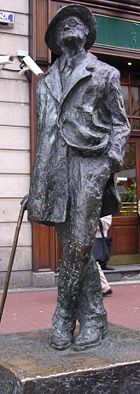
Literature, theatre and the arts
The city has a world-famous literary history, having produced many prominent literary figures, including Nobel laureates William Butler Yeats, George Bernard Shaw and Samuel Beckett. Other influential writers and playwrights from Dublin include Oscar Wilde, Jonathan Swift and the creator of Dracula, Bram Stoker. It is arguably most famous, however, as the location of the greatest works of James Joyce. Dubliners is a collection of short stories by Joyce about incidents and characters typical of residents of the city in the early part of the 20th century. His most celebrated work, Ulysses, is also set in Dublin and full of topical detail. Additional widely celebrated writers from the city include J.M. Synge, Seán O'Casey, Brendan Behan, Maeve Binchy, and Roddy Doyle. Ireland's biggest libraries and literary museums are found in Dublin, including the National Print Museum of Ireland and National Library of Ireland.
There are several theatres within the city centre, and various world famous actors have emerged from the Dublin theatrical scene, including Noel Purcell, Brendan Gleeson, Stephen Rea, Colin Farrell, Colm Meaney and Gabriel Byrne. The best known theatres include the Gaiety, the Abbey, the Olympia and the Gate. The Gaiety specialises in musical and operatic productions, and is popular for opening its doors after the evening theatre production to host a variety of live music, dancing, and films. The Abbey was founded in 1904 by a group that included Yeats with the aim of promoting indigenous literary talent. It went on to provide a breakthrough for some of the city's most famous writers, such as Synge, Yeats himself and George Bernard Shaw. The Gate was founded in 1928 to promote European and American Avante Guarde works. The largest theatre is the Mahony Hall in The Helix at Dublin City University in Glasnevin.
Dublin is also the focal point for much of Irish Art and the Irish artistic scene. The Book of Kells, a world-famous manuscript produced by Celtic Monks in A.D. 800 and an example of Insular art, is on display in Trinity College. The Chester Beatty Library houses the famous collection of manuscripts, miniature paintings, prints, drawings, rare books and decorative arts assembled by American mining millionaire (and honorary Irish citizen) Sir Alfred Chester Beatty (1875-1968). The collections date from 2700 B.C. onwards and are drawn from Asia, the Middle East, North Africa and Europe. Work by local artists is often put on public display around St. Stephen's Green, the main public park in the city centre. In addition large art galleries are found across the city, including the Irish Museum of Modern Art, the National Gallery, the Hugh Lane Municipal Gallery, The City Arts Centre, The Douglas Hyde Gallery, The Project Arts Centre and The Royal Hibernian Academy.
Three centres of the National Museum of Ireland are in Dublin.
Nightlife and entertainment
There is a vibrant nightlife in Dublin and it is reputedly one of the most youthful cities in Europe - with estimates of 50% of inhabitants being younger than 25. Furthermore in 2007, it was voted the friendliest city in Europe. Like the rest of Ireland, there are pubs right across the city centre. The area around St. Stephen's Green - especially Harcourt Street, Camden Street, Wexford Street and Leeson Street - is a centre for some of the most popular nightclubs and pubs in Dublin.
The most internationally notorious area for nightlife is the Temple Bar area just south of the River Liffey. To some extent, the area has become a hot spot for tourists, including stag and hen parties from Britain. It was developed as Dublin's cultural quarter (an idea proposed by local politician Charlie Haughey), and does retain this spirit as a centre for small arts productions, in the form of street performers and intimate small music venues. Gay pubs and clubs such as The Dragon, The George are centred on South Great George's Street and The Front Lounge is on Parliament street , and Pantibar on Capel Street.
Live music is popularly played on streets and at venues throughout Dublin in general and the city has produced several rock bands of international success, including U2, Hothouse Flowers, Horslips, The Boomtown Rats, Thin Lizzy, and Boyzone. The two best known cinemas in the city centre are the Savoy Cinema and the Cineworld Cinema, both north of the Liffey. Alternative and special-interest cinema can be found in the Irish Film Institute in Temple Bar, in the Screen Cinema on d'Olier Street and in the Lighthouse Cinema in Smithfield. Across suburban Dublin are located large modern multiscreen cinemas. Situated on the Liffey at the Eastlink tollbridge, the The Point Theatre is currently under renovation, but has housed performers including Madonna, Aerosmith and is noted for being the final performance of iconic popstar Britney Spears before her decline in publicity, and the final performance of American Pop-Punk band Blink 182
Sport
The headquarters of almost all of Ireland's sporting organisations is in Dublin, and the most popular sports in Dublin are those that are most popular throughout Ireland: Gaelic football, soccer, rugby union and hurling.
The city is host to the 4th largest stadium in Europe, Croke Park, the 83,700-capacity headquarters of the Gaelic Athletic Association. It traditionally hosts Gaelic football and hurling games during the summer months, as well as international rules football in alternating years. It also hosts concerts, with acts such as U2 and Robbie Williams having played there in recent years. The Dublin board of the Gaelic Athletic Association play their league games at Parnell Park.
Lansdowne Road stadium (previously owned by the Irish Rugby Football Union) was the venue for home games of both the Irish Rugby Team and the Republic's national soccer team. Until recently, it had a mixed standing and seating capacity of 49,000. However, as part of a joint venture between the IRFU and the FAI, it is currently being demolished and is expected to be replaced with a 50,000 all-seated stadium by 2009. Accordingly, rugby union and soccer home internationals have been temporarily moved to Croke Park.
Donnybrook Rugby Ground is the home of the Leinster Rugby team, which plays in the Magners League. They also play some important league and Heineken Cup matches at Lansdowne Road and have recently played these matches in the RDS.
Dalymount Park, in Phibsboro and the traditional Home of Irish Soccer, is now used only for home games of local club Bohemian F.C.. Rivals Shelbourne play at Tolka Park, in Drumcondra, while St Patrick's Athletic play in Richmond Park in Inchicore on the south west edge of the city. Shamrock Rovers, Ireland's most successful club, are originally from Milltown but have spent the last two decades in search of a home, and hope to complete a new stadium in Tallaght for the start of the 2009 season. The other senior soccer clubs are University College Dublin, based in Belfield and newly formed Sporting Fingal.
The National Aquatic Centre in Blanchardstown is the first building to open in the Sports Campus Ireland. There are several race courses in the Dublin area including Shelbourne Park ( Greyhound racing) and Leopardstown ( Horse racing). The world famous Dublin Horse Show takes place at the RDS, Ballsbridge, which hosted the Show Jumping World Championships in 1982. The national boxing arena is located in on the South Circular Road, though larger fights take place in the Point Depot in the docklands area. There are also Basketball, Handball, Hockey and Athletics stadia — most notably Morton Stadium in Santry, which held the athletics events of the 2003 Special Olympics.
The Dublin Marathon has been run since 1980, and the Women's Mini Marathon has been run since 1983 and is said to be the largest all female event of its kind in the world.
In recent years rugby league as a sport in Dublin has attained limited popularity. Two Dublin teams, the Dublin Blues and the North Dublin Eagles, play in Ireland's Lucozade elite League. Recent popularity has been increased with the Irish National Team's success in their qualifiers for the Rugby League World Cup to be held in Australia in 2008.
Shopping
Dublin is a popular shopping spot for both Irish people and tourists. Dublin city centre has several shopping districts, including Grafton Street, Henry Street, Stephen's Green Shopping Centre, Jervis Shopping Centre, and newly refurbished Ilac Shopping Centre (all popular meet-up spots for decades). On Grafton street, the most famous shops include Brown Thomas and its sister shop BT2, being akin to Bloomingdales in New York City, for example. Brown Thomas also contains "mini-stores" such as Hermès and Chanel on its Wicklow Street frontage. This is Dublin's nearest equivalent to a Designer shopping street such as Bond Street in London or 5th Avenue in New York City.
Dublin city is the location of large department stores, such as Clerys on O'Connell Street, Arnotts on Henry Street, Brown Thomas on Grafton Street and Debenhams (formerly Roches Stores) on Henry Street.
A major €750m development for Dublin city centre has been given the green light. The development of the so-called Northern Quarter will see the construction of 47 new shops, 175 apartments and a four-star hotel. Dublin City Council gave Arnotts planning permission for the plans to change the area bounded by Henry Street, O'Connell Street, Abbey Street and Liffey Street. The redevelopment will also include 14 new cafes along with a 149-bed hotel. It is expected that work on the new area will start in the second half of 2008. Prince's Street, which runs off O'Connell Street, will become a full urban street and pedestrian thoroughfare.
Since the mid 1990s, suburban Dublin has seen the completion of several modern retail centres. These include Dundrum Town Centre (on the Luas Green Line), Blanchardstown Centre, The Square in Tallaght (on the Luas Red Line), Liffey Valley Shopping Centre in Clondalkin, Northside Shopping Centre in Coolock, and Pavilions Shopping Centre in Swords.
Demographics
Dublin has a long history of emigration that continued into the early 1990s. Since then there has been net immigration and Dublin now has a significant population of immigrants. Foreign nationals in the city are primarily young and single and the greatest numbers come from the European Union, especially the United Kingdom, Poland and Lithuania. There is also a considerable number from outside Europe, particularly China, Nigeria, Brazil, Australia, New Zealand and Russia. 10% of the Republic of Ireland's population is now made up of foreign nationals, and Dublin is home to a greater proportion of new arrivals than other parts of the country - for example, 60% of Ireland's Asian population lives in Dublin even though less than 40% of the overall population live in the Greater Dublin Area.
Northside and Southside
A north-south division has traditionally existed in Dublin for some time, with the dividing line being the River Liffey. The Northside is seen by some as working-class (with the exception of the middle and upper middle class areas of Howth, Clontarf, Malahide, Portmarnock, Sutton and Castleknock) while the Southside is seen as middle and upper middle class. But this is not a clear divide in reality by any means and in fact it is only in recent times that the divided has taken on the present "rich and poor" badge. Traditionally it was a working class divide which began at Dublin docks in the early 1900s where depending which side of the Liffey a boat docked the dockers on that side got a day's work while those on the other side went home.
A noted theory on the division dates back some centuries, certainly to the point when the Earl of Kildare built his residence on the then less-regarded Southside. When asked why he was building on the Southside, he replied "Where I go, fashion follows me", and he was promptly followed by most other Irish peers.
Dublin postal districts have odd numbers for districts on the Northside — for example, Phibsboro is in Dublin 7 — and even numbers for the Southside — for example, Sandymount is in Dublin 4. An exception to the rule is Dublin 8, which straddles the river.
Education and research
Dublin is the primary centre of education in Ireland, with three universities and several other higher education institutions. There are 20 third-level institutes in the city. The University of Dublin is the oldest university in Ireland dating from the 16th century. Its sole constituent college, Trinity College, was established by Royal Charter under Elizabeth I and was closed to Roman Catholics until Catholic Emancipation; the Catholic hierarchy then banned Roman Catholics from attending it until 1970. It is situated in the city centre, on College Green, and has 15,000 students, the majority of whom are Catholics. The National University of Ireland (NUI) has its seat in Dublin, which is also the location of the associated constituent university of University College Dublin (UCD), the largest university in Ireland; although it is located in Dun Laoghaire-Rathdown, just outside the city boundary. Dublin City University (DCU) is the most recent university and specialises in business, engineering, and science courses, particularly with relevance to industry. The Royal College of Surgeons in Ireland (RCSI) is a medical school which is a recognised college of the NUI, it is situated at St. Stephen's Green in the city centre. The National University of Ireland, Maynooth, another constituent university of the NUI, is in neighbouring Co. Kildare, about 25 km (16 mi) from the city centre.
Dublin Institute of Technology (DIT) is a modern technical college and is the country's largest non-university third-level institution; it specialises in technical subjects but also offers many arts and humanities courses. It is soon to be relocated to a new campus at Grangegorman. Two suburbs of Dublin, Tallaght and Blanchardstown have Institutes of Technology: Institute of Technology, Tallaght, and Institute of Technology, Blanchardstown. Portobello College Dublin has its degrees conferred through the University of Wales.
The National College of Art and Design (NCAD) and Dun Laoghaire Institute of Art, Design and Technology (DLIADT) support training and research in art, design and media technology.
Dublin Business School (DBS) is Ireland's Largest Private Third Level Institution with over 9,000 students. The college is located on Aungier Street.
National College of Ireland (NCI)
There are also various other smaller specialised colleges, including private ones:
- Griffith College Dublin is located at the former Griffith Barracks on the South Circular Road, offering courses in Accountancy, Business, Law, Computing, Media & Journalism and Design.
- The Gaiety School of Acting hosts both a two year intensive degree in acting and a three year undergraduate BA degree in acting in conjunction with Dublin City University, and Dublin Business School, located on Aungier Street.
- The New Media Technology College provides specialised courses in film, performing arts, information technology, photography, interactive media and music technology (including a Master's degree and FETAC courses).
The Economic and Social Research Institute, a social science research institute, is based on Sir John Rogerson's Quay, Dublin 2. Institute of European Affairs is also in Dublin.
Population
The City of Dublin is the area administered by Dublin City Council, but the term normally refers to the contiguous urban area which includes the adjacent local authority areas of Dun Laoghaire-Rathdown, Fingal and South Dublin. Together the four areas form the traditional County Dublin. This area is sometimes known as 'Urban Dublin' or the ' Dublin Metropolitan Area'.
The population of the administrative area controlled by the City Council was 505,739 at the census of 2006. At the same census, the County Dublin population was 1,186,159, and that of the Greater Dublin Area 1,661,185. The city's population is expanding rapidly, and it is estimated by the CSO that it will reach 2.1 million by 2021. Today, approximately 40% of the population of the Republic of Ireland live within a 100 km (62 mi) radius of the city centre.
Economy and infrastructure
Industry, employment and standard of living
Dublin has been at the centre of Ireland's phenomenal economic growth over the last 10-15 years, a period (often of double-digit growth) referred to as the Celtic Tiger years. Living standards in the city have risen dramatically, although the cost of living has also soared. Dublin is now the planet's 16th most expensive city (8th most expensive city in Europe, excluding Russian cities). However, it has the second highest wages for a city in the world, ahead of both New York City and London, though behind Zürich.
Historically, brewing has probably been the industry most often associated with the city: Guinness has been brewed at the St. James's Gate Brewery since 1759. Since the advent of the Celtic Tiger years, however, a large number of global pharmaceutical, information and communications technology companies have located in Dublin and the Greater Dublin Area. For example, Microsoft, Google, Amazon, PayPal, Yahoo! and Pfizer (among others) now have European headquarters and/or operational bases in the city and its suburbs. Intel and Hewlett-Packard have large manufacturing plants in Leixlip, County Kildare, 15 km (9 mi) to the west.
Banking, finance and commerce are also important in the city — the IFSC alone handles over €1 trillion a year. Many international firms have established major headquarters in the city (eg. Citibank, Commerzbank). Also located in Dublin is the Irish Stock Exchange (ISEQ), Internet Neutral Exchange (INEX) and Irish Enterprise Exchange (IEX).
The economic boom years have led to a sharp increase in construction, which is now also a major employer, though, as of 2007, unemployment is on the rise as the housing market has begun to see supply outstrip demand. Redevelopment is taking place in large projects such as Dublin Docklands, Spencer Dock and others, transforming once run-down industrial areas in the city centre. Dublin City Council seems to now have loosened the former restrictions on "high-rise" structures. The tallest building, Liberty Hall, is only 59.4 m (194.9 ft) tall; already under construction in the city is Heuston Gate, a 117 m (384 ft) building (134 m including spire). The 120 m (394 ft) Britain Quay Tower and the 120 m (394 ft) Point Village Watchtower have been approved. Construction has started on the latter. Also the U2 Tower will be the tallest building on the Island of Ireland when it is finished.
In 2005, around 800,000 people were employed in the Greater Dublin Area, of whom around 600,000 were employed in the services sector and 200,000 in the industrial sector.
Economic growth is expected to slow in the coming years, with the Irish central bank predicting medium-term growth rates of around 3–5%. While this represents a slowdown relative to the early Celtic Tiger years, it is still stronger than growth in most other wealthy countries.
Transport
Dublin is also the main hub of the country's road network. The M50 motorway (the busiest road in Ireland), a semi- ring road runs around the south, west and north of the city, connecting the most important national primary routes in the state that fan out from the capital to the regions. As of 2008, a toll of €2 applies on what is called the West-Link, two adjacent concrete bridges that tower high above the River Liffey near the village of Lucan. The West-Link Toll Bridge is due to be replaced by a barrier-free tolling system in August 2008, with a three-tiered charge system based on electronic tags and car pre-registration.
To complete the ring road, an eastern bypass is also proposed for the city of Dublin. The first half of this project is the Dublin Port Tunnel which opened in late 2006 and mainly caters to heavy vehicles.
The capital is also surrounded by an inner and outer orbital route. The inner orbital route runs roughly around the heart of the Georgian city and the outer orbital route runs largely along the natural circle formed by Dublin's two canals, the Grand Canal and the Royal Canal, as well as the North and South Circular Roads.
Dublin is served by an extensive network of nearly 200 routes which serve all areas of the city and suburbs. The majority of these are controlled by Dublin Bus ( Bus Átha Cliath ) which was established in 1987 , but a number of smaller companies have began operating in recent years. Dublin Bus had 3408 staff and 1067 busses providing over half a million journeys per weekday in 2004. Fares are generally calculated on a stage system based on distance travelled. There are several different levels of fares, which apply on most services. Certain routes (particularly Xpresso) use a different fare system.
The Dublin Suburban Rail network is a system of five rail lines serving mainly commuters in the Greater Dublin Area, though some trains go even further to commuter towns such as Drogheda and Dundalk. One of these is an electrified line that runs along Dublin Bay and is known as the Dublin Area Rapid Transit (DART) line.
A two-line light rail/tram network called the Luas opened in 2004 and has proved popular in the (limited) areas it serves, although the lack of a link between the two lines is widely criticised. Five new luas lines are planned, the last of which will be opened in 2014, with the two existing lines set to be joined up by 2012.
There are plans to begin building work on the Dublin Metro (subway / underground) system set out in the Irish government's 2005 Transport 21 plan within the next few years. Although not confirmed, it is believed that the metro will be fully segregated from all traffic which will mean it will not disrupt traffic when in operation, unlike an on-street Luas Tram or the DART. The Metro North will bring rail access to areas and institutions currently lacking it, such as the Mater Hospital, Drumcondra ( Croke Park, inter-city and suburban rail stop), Dublin City University, Ballymun, Swords and Dublin Airport. The Metro West will serve the large suburbs of Tallaght, Clondalkin and Blanchardstown.
Dublin is at the centre of Ireland's transport system. Dublin Port is the country's busiest sea port and Dublin Airport is the busiest airport on the island.
Government
City
The City is governed by Dublin City Council (formerly called Dublin Corporation), which is presided over by the Lord Mayor of Dublin, who is elected for a yearly term and resides in the Mansion House. Dublin City Council is based in two major buildings. Council meetings take place in the headquarters at Dublin City Hall, the former Royal Exchange taken over for city government use in the 1850s. Many of its administrative staff are based in the controversial Civic Offices on Wood Quay.
The City Council is a unicameral assembly of 52 members, elected every five years from Local Election Areas. The party with the majority of seats decides who sits on what committee, what policies are followed, and who becomes Lord Mayor. Chaired by the Lord Mayor, the Council passes an annual budget for spending on housing, traffic management, refuse, drainage, planning, etc. The Dublin City Manager is responsible for the implementation of decisions of the City Council.
National
The national parliament of Ireland, the Oireachtas, consists of the President of Ireland and two houses, Dáil Éireann (Chamber of Deputies) and Seanad Éireann (Senate). All three are based in Dublin. The President of Ireland lives in Áras an Uachtaráin, the former residence of the Governor-General of the Irish Free State in the city's largest park, Phoenix Park. Both houses of the Oireachtas meet in Leinster House, a former ducal palace on the south side. The building has been the home of Irish parliaments since the creation of the Irish Free State on December 6, 1922.
The Irish Government is based in the Government Buildings, a large building designed by Sir Aston Webb, the architect who created the Edwardian facade of Buckingham Palace, as the Royal College of Science. In 1921 the House of Commons of Southern Ireland met here. Given its location next to Leinster House, the Irish Free State government took over part of the building to serve as a temporary home for some ministries. Both it and Leinster House, meant to be a temporary home of parliament, became permanent homes.
The old Irish Houses of Parliament of the Kingdom of Ireland are in College Green.
Climate
Dublin enjoys a maritime temperate climate characterised by mild winters, cool summers, and a lack of temperature extremes. Contrary to popular belief, Dublin does not experience as high rainfall as the West of Ireland, which receives twice that of the capital city. Dublin has fewer rainy days, on average, than London. The average maximum January temperature is 8 °C, the average maximum July temperature is 20 °C. The sunniest months, on average, are May and June. The wettest months, on average, are December and August, with 74 mm of rain. The driest month is April, with 45 mm. The total average annual rainfall (and other forms of precipitation) is 762 mm, lower than Sydney, New York City and even Dallas. Due to Dublin's high latitude, it experiences long summer days (around 19 hours of daylight) and short winter days (as short as nine hours). Like the rest of Ireland it is relatively safe from common natural disasters such as tornadoes, hurricanes, earthquakes and tsunamis.
Strong winds from Atlantic storm systems can affect Dublin, though usually less severe than other parts of Ireland. Severe winds are most likely during mid-winter, but can occur anytime, especially between October and February. During one of the stormiest periods of recent times, a gust of 151 km/h (94 mph) was recorded at Casement Aerodrome on 24 December 1997.
An urban heat island effect means Dublin is a few degrees warmer than surrounding areas. There is also a slight temperature difference between the city centre and the city's suburbs, with the city centre slightly warmer, as it is more built up. There are slight differences between the city centre and the Airport, just 12 km (7 mi) north.
The city is not noted for its temperature extremes due to its mild climate. Typically, the coldest months are December, January and February. Temperatures in summer in recent years have been rising to substantially above average figures, e.g. 31 °C in July 2006, over 11 °C higher than the average maximum. Recent heat waves include the European heat wave of 2003 and European heat wave of 2006.
The main precipitation in winter is rain. The city can experience some snow showers during the months from November to April, but lying snow is rare (on average, only 4/5 days). Hail occurs more often than snow, and is most likely during the winter and spring months. Another rare type of weather is thunder and lightning, most common in summer.
| Month | Jan | Feb | Mar | Apr | May | Jun | Jul | Aug | Sep | Oct | Nov | Dec | Year 2005-2006 |
|---|---|---|---|---|---|---|---|---|---|---|---|---|---|
| Average high | 8°C (46°F) |
8°C (46°F) |
10°C (50°F) |
13°C (55°F) |
15°C (59°F) |
18°C (64°F) |
20°C (68°F) |
19°C (66°F) |
17°C (63°F) |
14°C (57°F) |
10°C (50°F) |
8°C (46°F) |
13°C (56°F) |
| Average low | 1°C (34°F) |
2°C (36°F) |
3°C (37°F) |
4°C (39°F) |
6°C (43°F) |
9°C (48°F) |
11°C (52°F) |
11°C (52°F) |
9°C (48°F) |
6°C (43°F) |
4°C (39°F) |
3°C (37°F) |
6°C (42°F) |
| Total rainfall | 67 mm (2.6") | 55 mm (2.1") | 51 mm (2") | 45 mm (1.7") | 60 mm (2.3") | 57 mm (2.2") | 70 mm (2.7") | 74 mm (2.9") | 72 mm (2.8") | 70 mm (2.7") | 67 mm (2.6") | 74 mm (2.9") | 762 mm (29.5") |
Crime
Official statistics from An Garda Síochána for 2001-2005 show that the overall headline crime rate for the metropolitan area per 1,000 of population is the highest in the country. During the 1980s and 1990s, a heroin epidemic swept through working class areas of the inner city and outlying suburbs. Dublin had 80 homicides from 2004 to the end of 2006. 32 were gang-related. In 2007, as of mid July, there have been 15 homicides, in which 4 were gangland shootings. Dublin also has the largest number of fatal stabbings in Ireland.
Sister cities
- Barcelona, Catalonia, Spain (1998)
- Emmetsburg, Iowa, United States of America (1962)
- Liverpool, England, United Kingdom (1997)
- San Jose, California, United States of America (1986)
